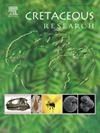New evidence of the global distribution of the swordfish-like pachycormid Protosphyraena in the late Early Cretaceous and a review of global records of the genus
IF 1.9
3区 地球科学
Q1 GEOLOGY
引用次数: 0
Abstract
Protosphyraena is one of the most widespread Cretaceous actinopterygian genera, with numerous species described primarily from the Upper Cretaceous of North America and Western Europe. However, most of the species are known from fragmentary and anatomically non-overlapping material, making the alpha taxonomy of this genus extremely problematic. Here we describe the first finds of Protosphyraena from the Albian of the Caucasus, and reassess the historical specimens from the Cenomanian of the Kursk Region of Russia. In an attempt to assign Russian specimens to a particular species, we review the global records and tangled taxonomy of Protosphyraena. The type species, P. ferox, is unambiguously known from teeth, cranial fragments and mandibles. The posteriorly directed rostral teeth of the type species cast doubt on the validity of Australopachycormus originally erected based on this feature. Our observations support the assignments of the historical Russian Cenomanian specimens to P. ferox and P. tenuirostris. We do not find sufficient cause to refer all isolated fins from Europe to P. ferox, as suggested by recent research. Instead, the species initially proposed by Agassiz for isolated fins from the English Chalk are available, and the fins of Protosphyraena from the Caucasus are consistent with one of these species, Protosphyraena gibberula comb. nov. Our findings indicate that Protosphyraena was widespread already in the late Early Cretaceous. Moreover, the youngest occurrence of Protosphyraena in Europe, a pectoral fin from the Maastrichtian of Belgium, demonstrates unique features and is thus referred to a new species, Protosphyraena terminata sp. nov.
早白垩世晚期剑鱼类栉水母全球分布新证据及该属全球记录回顾
Protosphyraena是白垩纪分布最广的腕足动物属之一,主要在北美和西欧的上白垩世描述了许多物种。然而,大多数物种都是从零散的、解剖结构不重叠的材料中得知的,这使得该属的阿尔法分类极为困难。在这里,我们描述了在高加索阿尔卑斯山首次发现的原角龙,并重新评估了俄罗斯库尔斯克地区仙人掌纪的历史标本。为了将俄罗斯的标本归入一个特定的物种,我们回顾了全球记录和纠缠不清的原尾柱虫分类法。从牙齿、头盖骨碎片和下颌骨中可以明确地了解到模式种--铁狐(P. ferox)。该模式种的喙齿向后,这使人们对最初根据这一特征建立的 Australopachycormus 的有效性产生了怀疑。我们的观察结果支持将历史上的俄罗斯塞诺曼时期标本归属于 P. ferox 和 P. tenuirostris。我们认为没有足够的理由将欧洲所有孤立的鳍鱼都归入P.相反,阿加西(Agassiz)最初为英国白垩纪的分离鳍提出的物种是可用的,而高加索地区的Protosphyraena鳍与其中的一个物种--Protosphyraena gibberula comb.nov.是一致的。我们的研究结果表明,早白垩世晚期,Protosphyraena已经广泛分布。此外,欧洲出现的最年轻的Protosphyraena--来自比利时马斯特里赫特期的胸鳍--显示出独特的特征,因此被称为一个新物种--Protosphyraena terminata sp.
本文章由计算机程序翻译,如有差异,请以英文原文为准。
求助全文
约1分钟内获得全文
求助全文
来源期刊

Cretaceous Research
地学-地质学
CiteScore
4.10
自引率
19.00%
发文量
235
审稿时长
12 weeks
期刊介绍:
Cretaceous Research provides a forum for the rapid publication of research on all aspects of the Cretaceous Period, including its boundaries with the Jurassic and Palaeogene. Authoritative papers reporting detailed investigations of Cretaceous stratigraphy and palaeontology, studies of regional geology, and reviews of recently published books are complemented by short communications of significant new findings.
Papers submitted to Cretaceous Research should place the research in a broad context, with emphasis placed towards our better understanding of the Cretaceous, that are therefore of interest to the diverse, international readership of the journal. Full length papers that focus solely on a local theme or area will not be accepted for publication; authors of short communications are encouraged to discuss how their findings are of relevance to the Cretaceous on a broad scale.
Research Areas include:
• Regional geology
• Stratigraphy and palaeontology
• Palaeobiology
• Palaeobiogeography
• Palaeoceanography
• Palaeoclimatology
• Evolutionary Palaeoecology
• Geochronology
• Global events.
 求助内容:
求助内容: 应助结果提醒方式:
应助结果提醒方式:


